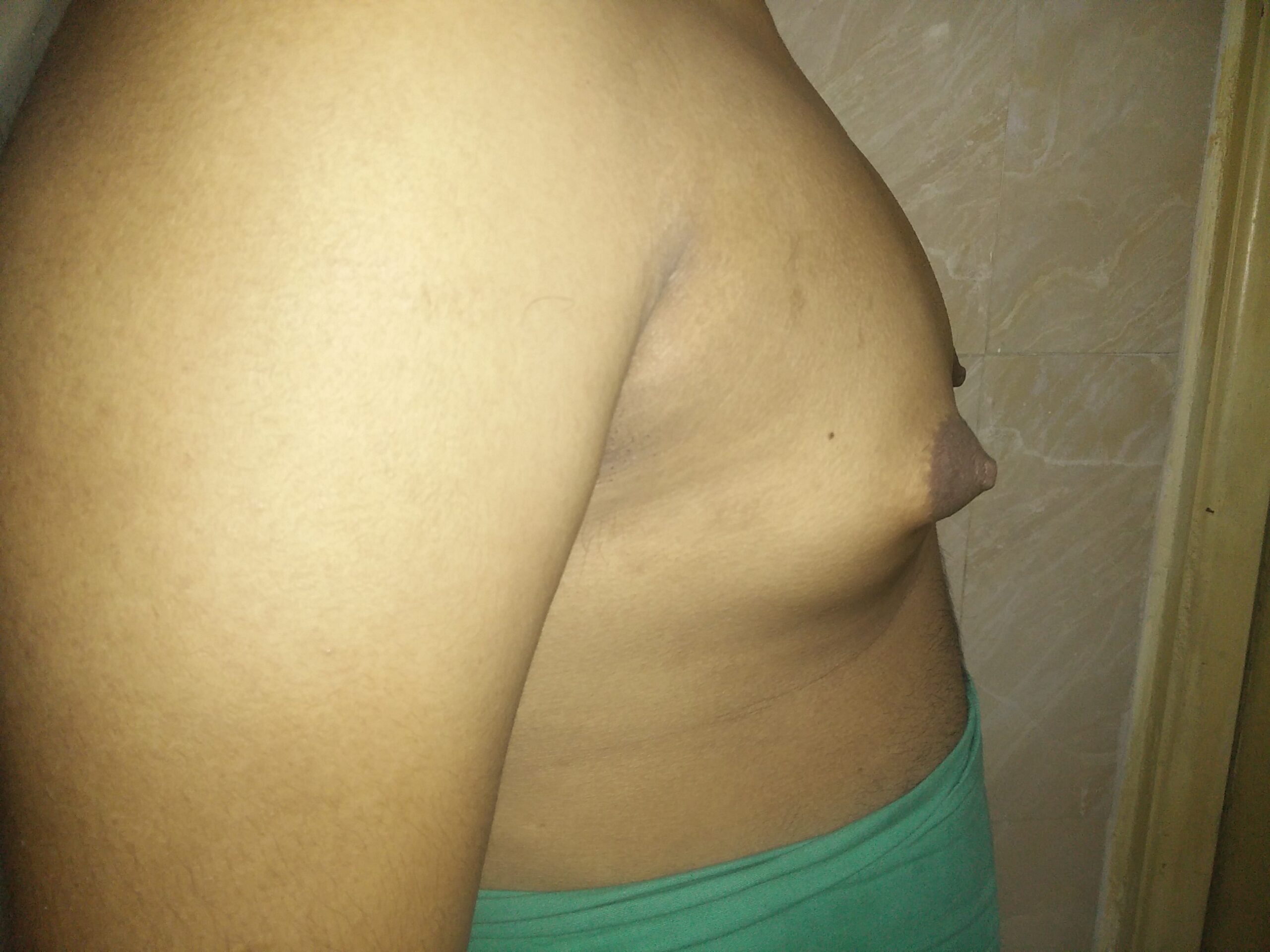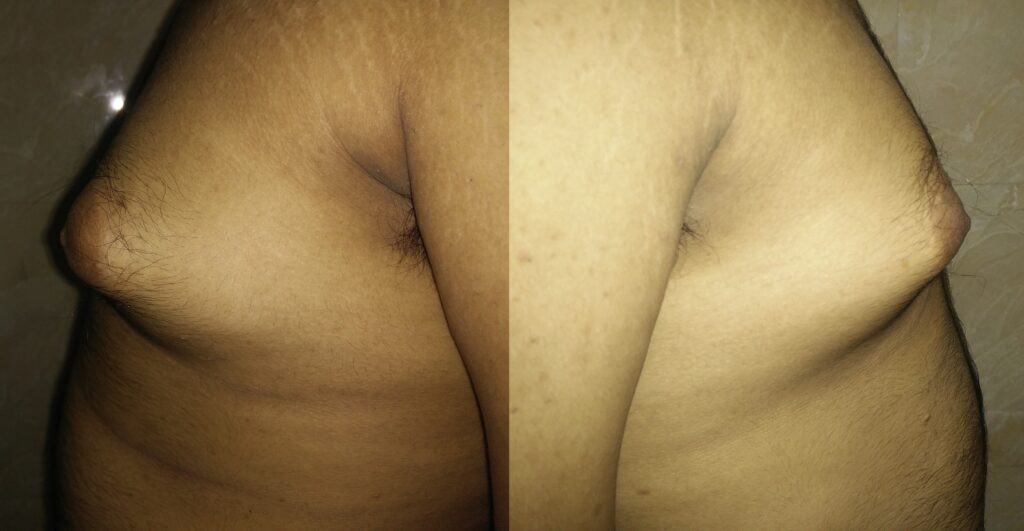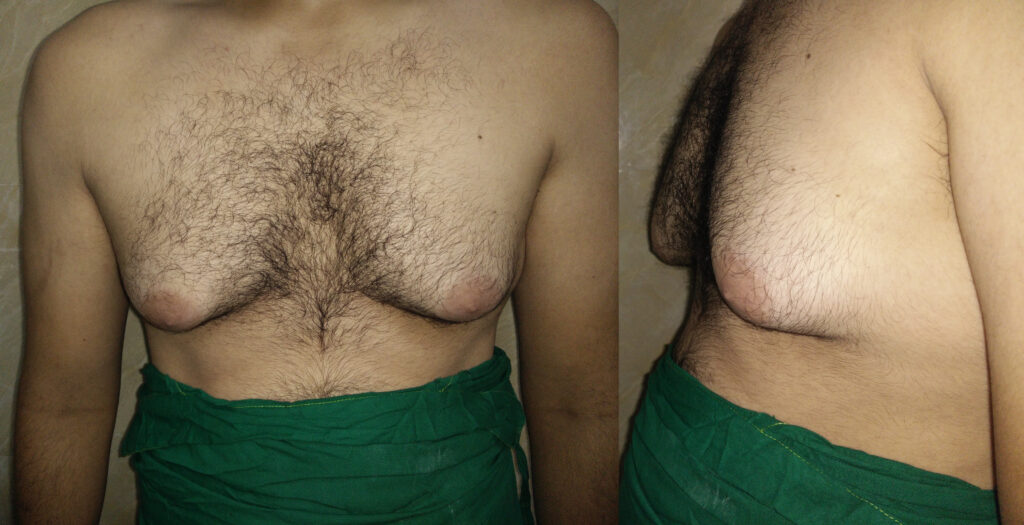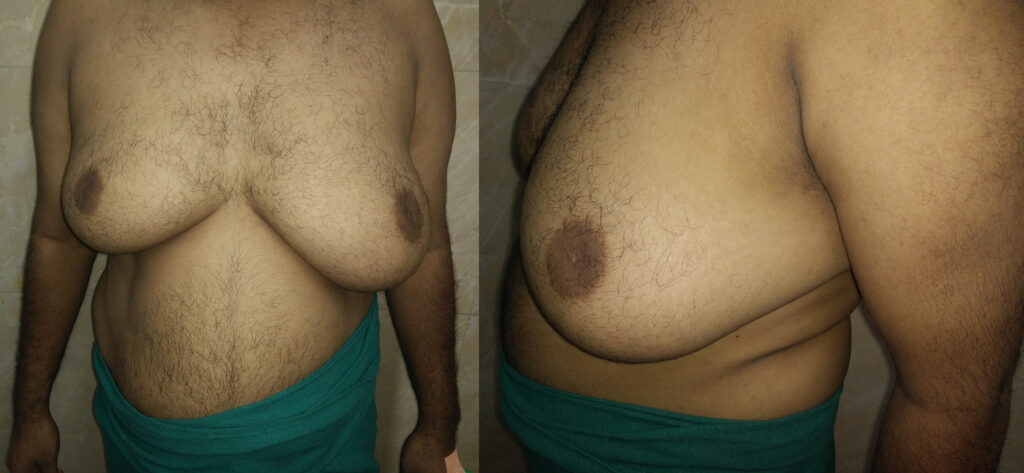Ideal Male Chest
The Target – An Ideal Male Chest
Before we go into details about the classification systems of Gynecomastia, we should have an idea about an “ideal male chest” because that should be the final target of the patients looking for correction of their “man boobs”. There are plenty of misconceptions regarding an ideal male chest with patients appearing confused about what to achieve.
So, what is an ideal male chest?

There are several components of the ideal male chest as detailed below:
Contour – Males have prominent musculature in their chest, the largest of the muscles being pectoralis major. Therefore, it is likely that the male chest should adopt the shape of the underlying pectoralis major muscle. As seen in the picture below, you can see that the pectoralis major muscle has a horizontal orientation as it comes out from the sternum and then moves up. This creates a distinct division between the lower border of the muscle and the abdomen. Therefore, the ideal male chest is NOT FLAT and has a definite fold separating the chest from the abdomen.
Nipple – The position of the nipple is around 5-6 above the lower chest fold described above and it points straight forward. In most patients, the nipple is located in the 4th intercostal space although in quite a few people it may be located in the 5th intercostal space.
Areola – The areolar diameter is around 2.66 cm or around 1 inch and it is flush with the surrounding skin.
Breast Tissue- In normal males, there is a thin layer of breast tissue which is firm to touch and not soft like fat. This can be observed by squeezing the pectoralis major muscle and then feeling under the nipple-areolar complex when the small breast tissue can be palpated. This should not make the nipple puffy. This small amount of breast tissue is kept during surgical removal to confer proper shape to the nipple and areola.
Pectoralis Major – This muscle lies behind the skin and breast tissue. The proportion of this muscle varies depending on whether the patient is thin or muscular.
Inframammary Fold – This is the chest fold that divides the chest from the abdomen. It is horizontal in normal patients but with accumulation of fatty and glandular tissue, the horizontal line tends to become rounded and more feminine.
Problems Associated With Gynecomastia
Breast Enlargement – The normal male architecture of the chest is lost and the chest takes on a feminine appearance. The breast swelling may appear rubbery or may be firm.
Breast Tenderness – In some patients the breasts might be painful, especially to touch when it is palpated by the patient or rubs against the clothing.
Nipple Changes – The appearance of the nipples changes and in many cases, these assume a conical and pointed shape which looks very unaesthetic. The affected person may use tight compression garments to hide this. He is unable to wear a T-shirt.
Lump – Patients may feel a lump under the nipples which gives rise to anxiety as many would think of this to be breast cancer.
Skin changes – With progressive enlargement, there might be dimpling of the skin, the areolar size increases and becomes unaesthetic and there may be stretch marks or striae over the chest.
Peer Ridicule – The affected person faces harassment from his peers who keep ridiculing him of the appearance of his chest. This might go on to physical harassment also. The condition is considered so much derogatory that a slang term MOOBS has been given to it.
Depression and other psychological problems – With progression, this condition leads to depression which might be severe to such an extent that suicidal thoughts may come to mind of these patients.
Classification of Gynecomastia
Now that we know what an ideal chest shape is, let us get into a few classification schemes of Gynecomastia.
Historically, there have been quite a few classification schemes for gynecomastia but the most widely adopted is the Simon’s Classification which is as under:
Grade 1 – small, visible breast enlargement with no skin redundancy; patients with puffy nipples will fall under this category.
Grade 2a – the breast enlargement is moderate without skin redundancy; the swelling now moves beyond the nipple-areolar complex.
Grade 2b – the breast enlargement is moderate with skin redundancy which is not severe.
Grade 3 – marked breast enlargement with marked skin redundancy and these patients’ condition mimics female breasts.
However, it might be difficult to classify all male breasts using this classification scheme alone as treatment approaches will vary according to grade. Seeing this, Dr. Cruise classified gynecomastia patients into 7 types as under –
Type I – Puffy Nipples


Type 2 – Breast tissue that engulfs the lower chest with a chest angle <45o

Type 3 – Sagging starts although it is mild in this stage with chest angle between 45o – 60o

Type 4 – Chest angle between 60o – 90o, there is moderate breast sag

Type 5 – Chest angle >90o with significant sag

Type 6 – Severe sag but still the top of the areola is above the inframammary fold

Type 7 – Extreme sag with the top of areola below the inframammary fold

Usefulness of Classification Scheme
The Classification scheme proposed by Dr. Cruise suggests the techniques used to address the various types of gynecomastia.
Early types such as Types 1-3 can be addressed by an incision at the lower margin of the areola only, the condition being, the skin elasticity should be good.
Some Type 3 and Type 4 patients can be addressed by a donut lift resulting in a periareolar scar.
Types 4-6 can be addressed by an anchor lift which produces an inverted T-shaped scar.
Some Type 6 and nearly all Type 7 patients would need a free nipple graft.
Atypical Forms of Gynecomastia
There are certain male breast enlargements which cannot be classified under the above schemes, Prof. (Dr.) Adhikari likes to classify them separately –
Asymmetric Gynecomastia
This condition is infrequent but not rare. In this condition, one side may have a higher grade of gynecomastia compared to the other. Sometimes, one side may not have gynecomastia at all, though this is rare.

Unilateral Gynecomastia
As mentioned above, one side may be affected only. The male breast on the other side may be quite big.

Tubular Breast Deformity
Although tubular breast deformity is seen in females, it can also be seen in males. In this condition, the breast is confined to behind the nipple-areolar complex and the tissue immediately surrounding it and undergoes descent or ptosis while the rest of the chest is intact.

The above recommendation for surgical management is not absolute and the techniques vary between individual surgeons and patient wishes. Prof. (Dr.) Adhikari would listen to the patient wishes and then opine about the best incisions so as to produce best results. His approach to Gynecomastia Surgery in Kolkata is quite different from other surgeons in that he will always address individual components of the surgery keeping the wishes of the patient in mind. If he feels that the results would be suboptimal with a particular procedure, he would be clear about this in the initial consultation.
Despite this, some touch-ups might be needed which are usually performed more than 6 months after the initial surgery.
Prof. (Dr.) Souvik Adhikari has proposed a new technique in Gynecomastia Surgery known as the “Minimal Incision Technique” where, following liposuction, small incisions are made through the nipple and the breast tissue taken out. The scars are hardly visible following surgery since these are strategically placed over the nipple and the final results are excellent. However, this is advocated only in Grade 1 and select Grade 2 patients.
